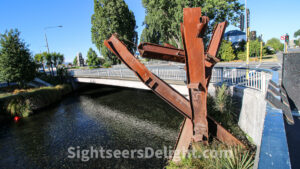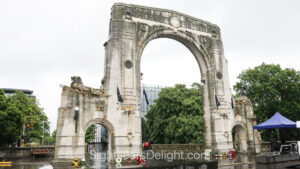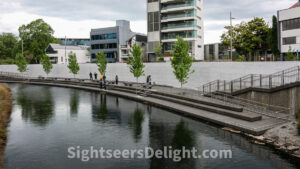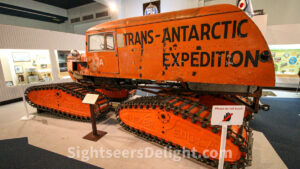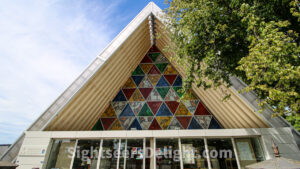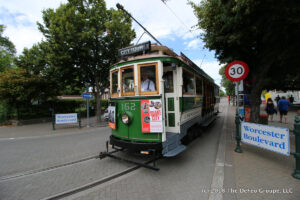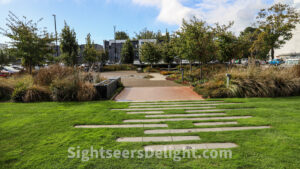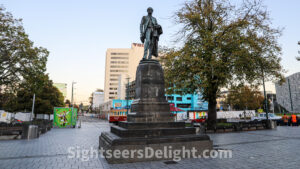The Bridge of Remembrance in Christchurch, New Zealand, is dedicated to as a memorial to those who participated in World War I and World War II as well as conflicts in Borneo, Korea, Malaya and Vietnam. The Cashel Street bridge over the Avon River initially opened in 1873. Mrs. Wyn Irwin is credited with raising the idea for a memorial atop the bridge in a July 24, 1919, letter to The Press on 24 July 1919. Lord Jellicoe unveiled the monument on Armistice Day (Nov. 11) in 1924. It closed to vehicle traffic in 1976. Following the February 2011 Christchurch earthquake, New Zealand spent more than NZD 2 million to strengthen the historic bridge.
The Canterbury Earthquake National Memorial opened on Feb. 22, 2017, the sixth anniversary of the 2011 earthquake that claimed the lives of 185 people. The memorial, located in a gentle curve of the Avon River in the heart of Christchurch, pays respect to those who died, were seriously injured and survivors. The memorial’s name, Oi Manawa, means “tremor or quivering of the heart.”
Julius von Haast, a German geologist, founded the Canterbury Museum in 1867. He used his collection as the core of the museum’s exhibits. The Canterbury Museum opened to the public in December 1867 and moved to its current location in October 1870. The museum is part natural history museum and part history museum. Its extensive holdings include the largest collection in the world of Antarctic objects from the age of exploration and discovery.
After the 2011 Christchurch earthquake heavily damaged the Christchurch Cathedral, Japanese architect Shigeru Ban designed the Cardboard Cathedral pro bono to serve as a transitional cathedral. The Cardboard Cathedral, part of the Anglican Diocese of Christchurch, opened in August 2013. The A-frame in style structure rises 79 feet tall and uses 86 cardboard tubes sitting on top of 20-foot-long shipping containers. Despite its controversial design, the transitional cathedral is a popular destination for tourists to the city. The Anglican Diocese built the structure on the site of St John the Baptist Church, the first church built in permanent materials by Anglicans in Christchurch. The 2011 earthquake destroyed the church.
Christchurch Art Gallery Te Puna o Waiwhetu opened in May 2003 and replaced the former Robert McDougall Art Gallery, which opened in 1932. The Christchurch Art Gallery is home to works by both New Zealand and international artists. Following the 2010 Canterbury earthquake and the February 2011 Christchurch earthquake, Civil Defence used the building as a headquarters. The art gallery reopened in December 2015 following extensive refurbishments.
The Christchurch Botanic Gardens traces its origin to 1863. That year, an English oak was planted to commemorate the marriage of Prince Albert and Princess Alexandra of Denmark. The gardens are located next to the loop of the Avon River and Hagley Park. The gardens, which cover 21 hectares, are home to a collection of local and exotic plants. Its collection includes plants from across the globe.
Christchurch Tram’s heritage tramcars offer a unique way to explore Christchurch’s inner city. Operating since 1995, the trams offer live commentary from your friendly driver along the 4-kilometer circuit. Your all-day ticket allows you to discover the delights of the central city at your leisure with stops at Christchurch’s major sights, including Canterbury Museum and Botanic Gardens, Arts Centre, Art Gallery, The Terrace and Riverside Market and New Regent Street. Eco-friendly and Qualmark Gold accredited, the Christchurch Tram is a must-do activity on any visit to the city
The CTV Memorial Site stands on the site of the former Canterbury Television (CTV) headquarters at the corner of Cashel and Madras Streets in Christchurch. The building was destroyed during the February 2011 Christchurch earthquake. The building collapsed, killing 115 people, representing 60% of the fatalities during the earthquake.
John Robert Godley was an Anglo-Irish statesman and bureaucrat. Godley is considered the founder of Canterbury, New Zealand, although he lived there for only two years. A bronze statue bearing his likeness was erected in Cathedral Square by the people of Christchurch in 1867. Artist Thomas Woolner designed the statue, which fell off its pedestal during a February 2011 earthquake.

